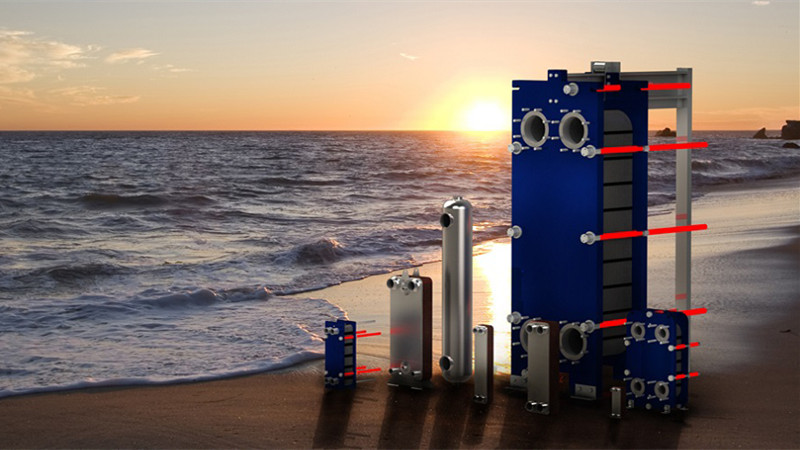- Menu
- Search For Product Models
Search For Product Models
- cn

Heat exchangers are used across industries to efficiently transfer heat between fluids — whether heating, cooling, condensing, or evaporating. Each design type has its own structure, flow characteristics, and performance advantages, making proper selection essential for reliability and efficiency.
**Design Highlights:**
· • Stainless-steel plates brazed with copper or nickel
· • High pressure rating up to 45 bar, temperature up to 200 °C
· • Compact, maintenance-free, and highly efficient
· • Low pressure drop and minimal hold-up volume
**Applications:**
· • Heat pumps, chillers, and domestic hot-water systems
· • Refrigeration systems (CO₂, R410A, R32)
· • Industrial oil and process fluid cooling
**Design Highlights:**
· • Plates sealed with replaceable gaskets for easy maintenance
· • Operating pressure up to 25 bar, temperature up to 180 °C
· • Capacity adjustable by adding or removing plates
· • High efficiency with small temperature difference (ΔT ≈ 1–3 K)
**Applications:**
· • District heating and cooling networks
· • Food, beverage, and pharmaceutical processes
· • Cooling-water and heat-recovery systems
**Design Highlights:**
· • Combines welded strength with serviceability
· • Leak-free gas side for ammonia or aggressive refrigerants
· • Handles higher pressure and chemical loads
· • Moderate pressure drop with turbulent flow
**Applications:**
· • Ammonia evaporators and condensers (R717)
· • Brine and glycol refrigeration circuits
· • Chemical process cooling
**Design Highlights:**
· • Fully welded plate core enclosed in pressure shell
· • Withstands up to 100 bar and 400 °C
· • Compact, leak-tight, and vibration-resistant
· • Suitable for two-phase and high-pressure duties
**Applications:**
· • Oil & gas and marine cooling systems
· • Steam condensers and heat-recovery units
· • High-temperature process loops
**Design Highlights:**
· • Laser-welded inflated plates forming turbulence pockets
· • Excellent for large-surface, low-pressure-drop applications
· • Flexible geometry — can be curved, conical, or panel-type
· • Handles uneven pressure on each side
**Applications:**
· • Tank walls and process jackets
· • Falling-film chillers and evaporators
· • Thermal energy storage systems
**Design Highlights:**
· • Self-cleaning single-path design minimizes fouling
· • Tolerates sludge, fibers, or viscous fluids
· • Compact footprint compared to shell-and-tube units
· • Easy to isolate and clean by flushing
**Applications:**
· • Wastewater or sludge heating
· • Pulp and paper or chemical recovery lines
· • Heat recovery from dirty or fouling streams
**Design Highlights:**
· • Operates under very high pressure (≤ 200 bar) and temperature (≤ 600 °C)
· • Strong mechanical structure for phase-change duties
· • Adjustable for low pressure drop or high turbulence
· • Suitable for multi-pass configurations
**Applications:**
· • Steam condensers and reboilers
· • Petrochemical and refinery processes
· • Marine engines and compressor cooling
Factor | Description | Typical Range |
Pressure Resistance | Structural ability to withstand high system pressure | BPHE > Shell & Plate > GPHE |
Temperature Range | Operational temperature limit of materials/gaskets | Up to 600 °C (Shell & Tube) |
Pressure Drop | Flow resistance; affects pumping power | Lowest in Pillow/Spiral types |
Maintenance | Ease of disassembly and cleaning | Best in GPHE / Spiral |
Fouling Resistance | Ability to handle dirty or viscous media | Spiral > Shell & Tube > BPHE |
Compactness | Heat duty per unit volume | BPHE > Shell & Plate |
Cost Level | Initial and life-cycle cost | BPHE < GPHE < Shell & Plate |
There is no universal 'best' heat exchanger — each represents a balance between thermal performance, mechanical strength, maintenance, and cost. By evaluating key process factors such as pressure, temperature, fouling tendency, and allowable pressure drop, engineers can select the configuration that ensures both energy efficiency and long-term reliability.